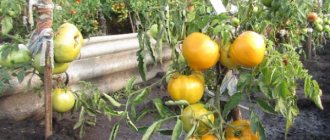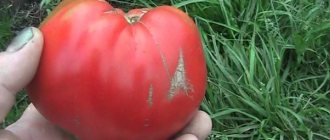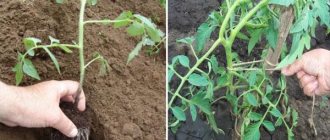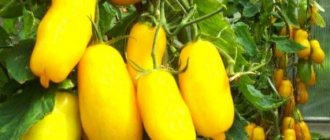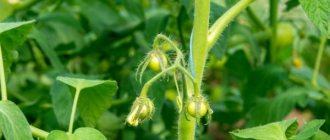Characteristics, description of the Black Prince variety with photo
The Black Prince tomato was bred by Chinese breeders. It was entered into the State Register of the Russian Federation in 2000.
Black Prince is a mid-season, indeterminate tomato variety. Has almost 100% seed germination.
This variety loves warm air, so it is usually grown in a greenhouse.
- The variety is not suitable for planting in northern regions where summers are short and cool.
- In the southern regions it can also be grown in open ground, provided with a garter to trellises.
The growing season from the appearance of the first shoots to the beginning of tomato ripening lasts about 115-125 days.
The first ripe tomatoes appear 2 months after planting the seedlings in a permanent place. As a rule, this happens at the end of June.
- The tomato bush grows up to 2-2.5 meters.
- The plant has a strong stem and a powerful root system.
- The foliage cover is very high.
- Leaves are medium sized, pointed.
- The color of the leaves is rich green, slightly darker than other tomatoes.
- The first ovary, with a large number of stalks, appears above the 7-9 leaves, and the subsequent ones every three leaves.
- 6-8 fruits are formed on one brush. But in order for the tomato to weigh more, it is recommended to leave no more than 5-6 flowers on each ovary. Fruit ripening is uniform and uniform. One plant can bear up to 50 fruits at the same time.
The fruits of the Black Prince tomato have a regular flat-round shape. The average weight of tomatoes is 120-180 g, the cut of a tomato is 5 cm. The color of the skin of ripe fruits is red-brown. The stalk has a small green spot. The skin of tomatoes is dense and smooth, with a glossy sheen.
The flesh is burgundy, dense and juicy. The taste is sweet, without sourness. There are not very many seeds in the fruits. Ripe fruits cannot be stored for long periods of time.
These tomatoes are suitable for fresh consumption; they are also very tasty in winter salads and sauces.
They are not suitable for whole canning, since the skin will crack when poured with marinade.
Not so long ago, this variety appeared in the first generation F1 hybrid of the same name. But you need to know that it is impossible to obtain good seed offspring from hybrid plants. Therefore, when purchasing seed, you need to make sure that the bag of seeds clearly indicates that it is the Black Prince variety.
Seeds should be purchased only from well-known and trusted companies, in special stores.
Useful video
Watch the video: Black Prince tomato
| Mid-season | Mid-early | Late ripening |
| Anastasia | Budenovka | Premier |
| Raspberry wine | Mystery of nature | Grapefruit |
| Royal gift | Pink King | De Barao the Giant |
| Malachite Box | Cardinal | De Barao |
| Pink heart | Babushkino | Yusupovsky |
| Cypress | Lev Tolstoy | Altaic |
| Giant raspberry | Danko | Rocket |
If you find an error, please select a piece of text and press Ctrl+Enter.
Features of cultivation
To obtain seedlings, tomato seeds are sown in late February-early March. The soil for planting is chosen to be loose and fertile. The seeds are planted in preheated soil to a depth of no more than 1.5-2 cm. The soil with plantings is moistened with a spray bottle and covered with glass or film.
D
For seed germination, the ideal air temperature is +25°C.
After seed germination (after about 5-7 days), it is necessary to remove the cover and reduce the temperature to + 17 °C. Watering is carried out as the top layer of soil dries.
In order for seedlings to grow well, they need to be provided with long daylight hours (at least 12-14 hours). If there is a lack of sunlight, fluorescent or other fluorescent lamps are used.
They start picking seedlings when two or three true leaves appear on them. Plants are transplanted into separate cups.
Adult seedlings are planted in a permanent place of growth in early May.
Choose a site for planting tomatoes that is well lit and without drafts. The soil should be loose and fertile. If necessary, humus is added to the soil - 5-10 kg per 1 square meter. m. Seedlings are planted in a permanent place of growth at the age of 50-60 days.
The bed where the tomatoes will be planted is dug up and small holes are made. The distance between plants should be at least 60 cm. A little phosphorus-containing fertilizer is added to each hole. Planted plants must be well watered.
It is necessary to water adult plants only at the root. It is not recommended to use the sprinkling method. Water about 1-2 times a week with about 2-3 liters of water per hole. The water should be warm and settled.
The formation of a bush is carried out in one or two stems. If you leave more stems, few fruits will set and they will take longer to ripen. When forming a bush into one stem, it is necessary to remove all the stepsons, and if there are two stems, then it is necessary to leave the one that grows under the first brush.
Bushes need to be tied to trellises or stakes. Fruit clusters also need to be tied up, otherwise they will break under the weight of the tomato. Weeding and removal of all grown stepsons must be carried out. It is also necessary to loosen and mulch the soil between the bushes.
It is advisable not to apply nitrogen-containing fertilizers until the 3rd flower cluster blooms. After the onset of this phase, the tomato bushes must be fed with stimulants and mineral fertilizers (after 10-14 days). You can also additionally use liquid manure (no more than 3 times per season).
Despite the fact that the variety is quite resistant to many diseases, prevention is still worth carrying out. Tomato bushes are treated with special biological preparations.
Tomato care
Competent and rational care of the crop will allow you to get the highest possible yield, and the taste of the fruit will noticeably improve.
Top dressing
According to the description, the Black Prince reacts positively to additional fertilizing, which enriches the soil with nutrients. The large root system of the plant pulls them out of the soil in large quantities, so it is necessary to replenish them regularly.
- 10-14 days after transplanting the seedlings, they are fertilized with organic substances. To 10 liters of water add 500 g of mullein and 2 tbsp. superphosphate.
- 20-25 days after the first feeding, a second feeding is carried out using mullein and potassium sulfate (for 10 liters of water - 500 g of mullein and 1 full tablespoon of the specified fertilizer).
- Every 10-14 days, the soil is moistened with water with mullein and rotted peat.
- After budding of the crop, before fruiting begins, the soil is fertilized with potassium-phosphorus substances.
Watering
After planting seedlings in the ground, for the first time it is necessary to water daily in the evening. To do this, use warm rain or settled water. After the young seedling has adapted to the new location, they begin to systematically reduce the procedure, carrying it out as the soil dries.
():
There is no need to water frequently immediately after planting. The first post-planting watering is carried out 5-7 days after planting the seedlings. Frequent watering at this time has a negative effect on the root system, making it soft and superficial. The tomato is a fairly drought-resistant plant that can independently “extract” water from the soil.
Excess moisture in the soil can provoke fungal and infectious diseases of the root system, so watering should be regular but moderate.
Diseases and their prevention
Common diseases that pose a danger include:
- late blight
- fusarium wilt
- brown spot
In most cases, the disease can be triggered by improper crop care: too frequent and excessive watering, poor preparation and cultivation of the soil for planting.
To prevent this, it is important to follow these recommendations:
- adhere to the watering regime;
- disinfect the soil and seeds before planting;
- timely treat the crop with preventive drugs (Fitosporin, Trichodermin, etc.)
Reviews from gardeners who planted
Vadim, Pskov region
I would like to note the exotic taste of Black Prince tomatoes, the pulp of which is very juicy and tender. The fruits ripen very well. I advise every gardener to plant this variety as seedlings.
Valentina, 48 years old
This tomato is truly a miracle. I will plant next year too. It has a very unusual and beautiful shade. I planted seedlings in a film greenhouse. The tomato didn't hurt at all. It has an unusual taste and aroma; it makes very tasty salads.
Victoria, 53 years old
I have always been attracted to unusual tomatoes. And I couldn’t ignore this almost black variety. I would like to note its resistance to many diseases. Does not require any special growing conditions. I was pleased with the high yield - about 2.5 kg per bush.
Olga, 47 years old
I planted a Black Prince tomato in a regular garden bed. Overall, I liked the tomato. Tomatoes are an unusual color and delicious. I was pleased with the resistance to diseases. Although I still carry out sanitary measures on the beds, since I grow different varieties of tomatoes.
Tamara, 55 years old, Chelyabinsk
I really like the taste and appearance of Black Prince tomatoes. But to get a good harvest you have to tinker a lot. But the effort expended is compensated by the abundance of amazing and exotic fruits. I recommend it to all gardeners, you won’t regret it.
Nadezhda Ivanovna, 63 years old, Ural
I really like the taste of the Black Prince tomato. For some reason, my yield is no more than 1.5 kg per bush, but the beauty and unusual taste amaze me. The bushes grew up to 2 meters. I always grew it in a greenhouse, growing the bush in one stem. If you have never grown this tomato before, I definitely recommend giving it a try. I am very pleased with this variety.
Advantages and disadvantages
The Black Prince tomato variety, like any other, has its pros and cons.
The undoubted advantages include the original color of its fruits, due to the content of anthocyanins in them. These substances are necessary to maintain immunity, are the strongest antioxidants that prevent the development of cancer, and are needed for normal vision.
The fruits of the Black Prince variety are very fleshy and contain a lot of sugary substances, which is why they are classified as dessert fruits.
These tomatoes are quite resistant to many diseases, including late blight. An unpretentious variety, it can be planted both in open ground and under cover, and is not particularly demanding on the composition of the soil.
Another advantage is the productivity of these tomatoes; from 1 m2 you can harvest up to 7 kg of tomatoes, and from one bush you can harvest up to 4 kg. They bear fruit until frost.
The disadvantages of black prince tomatoes include:
- poor keeping quality, they need to be consumed or processed within 2-3 days after collection;
- poor transportability, which is why the variety is preferred by summer residents rather than farmers;
- tendency of fruits to crack due to thin skin;
- the need to pinch out growing points on bushes.
How to care for the crop?
The rules of care in a greenhouse and in open ground are almost the same. There is nothing complicated. The main thing is to take care of the plant, and it will reward you with a high yield.
Watering
In open ground, seedlings need less frequent watering than greenhouse sprouts, since the temperature under the film is slightly higher. Garden bushes need to be watered twice a week, and greenhouse bushes 3 times. But this rule only applies when it is sultry outside. As temperatures drop, you need to make sure the soil dries out.
See also Features of cultivation and characteristics of the Tretyakovsky F1 tomato with reviews
Temperature
Air heating is controlled only in greenhouses. If it is above 24 °C, you need to ventilate.
Weeding
This procedure is necessary to enrich the root system with oxygen. It is recommended to weed the next day after watering.
Feeding and fertilizers
Every two weeks you need to fertilize tomato bushes. It is important to alternate root and foliar feeding.
Gardeners add to the root:
- manure (diluted with water);
- broad-spectrum liquid fertilizers (“Gumad”, “Emerald” or “Ideal”);
- humus.
For leaves use:
- "Epin";
- calcium nitrate;
- "Immunocytophyte";
- boric acid;
- yeast;
- urea
There is no need to spray plants in hot weather, as the sun's rays can cause burns.
Garter and shaping
As the seedlings grow, they will need to be tied to a support and stepsoned (you need to tear off all the stepsons from the plant). Bushes are formed one at a time. So that the tomatoes have time to ripen before the onset of cold weather, the top of the head is pinched (cut). In a greenhouse, this procedure is carried out in August, and on garden seedlings in mid-July.
Disease resistance
Black Prince tomatoes have good immunity to many nightshade phytopathologies, but prevention will not be superfluous. For outdoor cultivation, it is recommended to use growth stimulants; they not only help plants grow stronger, but also significantly increase immunity.
Since the Black Prince needs abundant watering, the bushes in the greenhouse are regularly ventilated so that high humidity does not provoke the development of late blight. Mulching is also practiced for the same purpose. Treatment with vitriol solution will also prevent the described illness.
